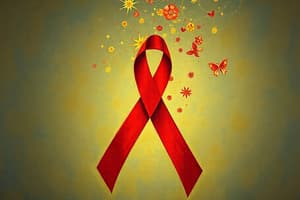Podcast
Questions and Answers
Why are electrolytes like phosphorous, potassium, and magnesium evaluated daily and replenished intravenously in patients with wasting syndrome or disease?
Why are electrolytes like phosphorous, potassium, and magnesium evaluated daily and replenished intravenously in patients with wasting syndrome or disease?
- To correct imbalances that can lead to arrhythmia and respiratory arrest. (correct)
- To stimulate appetite and increase food intake.
- To enhance the absorption of oral medications.
- To prevent the buildup of toxins due to decreased kidney function.
A client living with HIV experiences persistent nausea. Which dietary strategy is MOST appropriate to recommend?
A client living with HIV experiences persistent nausea. Which dietary strategy is MOST appropriate to recommend?
- Drink plenty of liquids, especially during meals.
- Consume small, frequent meals or snacks every 1-2 hours. (correct)
- Increase intake of high-fat foods to promote satiety.
- Completely avoid eating until the nausea subsides.
Why is water safety critically important for individuals with HIV?
Why is water safety critically important for individuals with HIV?
- Because individuals with HIV are more susceptible to dehydration.
- Because individuals with HIV have a lower tolerance for tap water.
- Because contaminated water can introduce parasites, bacteria, and viruses, leading to infections. (correct)
- Because certain HIV medications require increased water intake for proper absorption.
Which of the following is the MOST important consideration regarding protein intake for a person with HIV experiencing wasting?
Which of the following is the MOST important consideration regarding protein intake for a person with HIV experiencing wasting?
A person with HIV is experiencing diarrhea. Which of the following dietary modifications is MOST appropriate?
A person with HIV is experiencing diarrhea. Which of the following dietary modifications is MOST appropriate?
What is the primary rationale behind recommending against raw seafood or sushi for individuals with HIV?
What is the primary rationale behind recommending against raw seafood or sushi for individuals with HIV?
When should fruits and vegetables be washed, to ensure food safety, for a person living with HIV?
When should fruits and vegetables be washed, to ensure food safety, for a person living with HIV?
What is the MOST critical action to take if mold is discovered on a food item, such as fruit or cheese?
What is the MOST critical action to take if mold is discovered on a food item, such as fruit or cheese?
A client with HIV is struggling to maintain adequate energy intake. Which of the following strategies would be MOST appropriate to assess their energy needs?
A client with HIV is struggling to maintain adequate energy intake. Which of the following strategies would be MOST appropriate to assess their energy needs?
Why is it important to use a separate cutting board for raw meats when preparing food for someone with HIV?
Why is it important to use a separate cutting board for raw meats when preparing food for someone with HIV?
Flashcards
Energy needs calculation
Energy needs calculation
Basal metabolic rate + Physical activity + disease-related elevation (disease factor)
Protein intake for HIV
Protein intake for HIV
1.5-1.8 g/kg body weight; may be higher during secondary or opportunistic infection.
Refeeding syndrome
Refeeding syndrome
Life-threatening shifts in fluids and electrolytes that can result in arrhythmia, respiratory arrest, and death.
Food safety for HIV
Food safety for HIV
Signup and view all the flashcards
Managing nausea
Managing nausea
Signup and view all the flashcards
Managing diarrhea
Managing diarrhea
Signup and view all the flashcards
Study Notes
- Date: 1/22/2025
Dietary Management
- Energy needs are calculated by basal metabolic rate + physical activity (PA) + disease-related elevation, using a disease factor
- Indirect calorimetry or Harris-Benedict Equation (HBE) may be used
Protein Intake
- High protein intake: 1.5-1.8 g/kg bw
- Necessary because it is exacerbated during secondary or opportunistic infection and wasting
Wasting Syndrome/Disease
- Electrolyte deficits may indicate a risk for refeeding syndrome
- Sudden death can occur due to arrhythmia and respiratory arrest, caused by acute intravascular volume expansion, serum phosphate depletion, hypokalemia, and hypomagnesemia
- Electrolytes (phosphorous, potassium, and magnesium) should be evaluated and replenished intravenously daily
- Source: University of Santo Tomas Department of Nutrition and Dietetics
Food Safety
- Individuals living with HIV/AIDS have a higher risk for food borne illness so basic guidelines are important
Basic Guidelines
- Avoid raw eggs, meats, or seafood
- Wash fruits and vegetables thoroughly
- Discard old foods or foods with mold or rotten spots
- Use separate cutting boards for raw meats
- Wash hands, utensils, and cutting boards after each use
- Water safety is important due to potential parasites, bacteria, and viruses
Managing Symptoms: Nausea
- Try ginger tea, ginger ale, or ginger snaps
- Avoid drinking liquids while eating meals
- Eat a small snack, like crackers, before getting out of bed
- Eat a small snack every 1–2 hours to maintain stomach contents
Managing Symptoms: Diarrhea
- Follow a low residue, no fatty, and no oily diet
- Stay hydrated with water or other caffeine-free fluids
- Limit sodas and sugary drinks
- Avoid greasy and spicy foods
- Avoid milk and other dairy products
- Eat small snacks and meals every 1-2 hours
Recommended Reading
- National Counselling Cards for People Living with HIV/AIDS and/or Tuberculosis: https://www.fantaproject.org/sites/default/files/resource/Uganda-Counselling-Cards-PLHIV-March2016.pdf
Studying That Suits You
Use AI to generate personalized quizzes and flashcards to suit your learning preferences.




